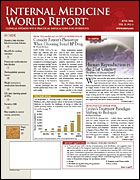Publication
Article
Internal Medicine World Report
PSA Accuracy Drops and Prostate Cancer Mortality Rises with BMI >30
PSA Accuracy Drops and Prostate Cancer Mortality Rises with BMI >30
obesity, defined as a body mass index (BMI) >30 kg/m2, appears to contribute
to inaccurately low prostate- specific antigen (PSA) readings, leading
to misleading test results and the possibility of delayed diagnosis and increased
mortality, according to a study published in Cancer (2005;103:1092-1095).
“Previous studies show that obesity is associated with more aggressive prostate cancer
disease,” lead investigator Jacques Baillargeon, PhD, of the Center for Epidemiology &
Biostatistics, University of Texas Health Science Center, San Antonio, told IMWR.
“PSA levels decrease as BMI increases, even after adjusting for race and age. It is likely thatPSA is being suppressed in overweight and obese men, possibly as a result of lower testosterone
levels. This may result in delayed prostate cancer diagnosis. Such delay may
result in more aggressive disease and poorer overall survival in this group.” An American Cancer Society study published in April 2003 added prostate cancer to its list of obesity-associated diseases. Some have hypothesized that there is a tumorigenic link to elevated estrogen or human growth factor, while others, including Dr Baillargeon and colleagues, have hypothesized
that obesity could make PSA screening less sensitive, leading to later-stage disease at
diagnosis and higher mortality. In this study, BMI and PSA level correlations
were studied in 2779 men. Results showed that median PSA scores declined as median BMI rose, with statistical consistency across age and race. Men in the highest BMI group showed a 34% increase in prostate cancer mortality risk. “Some physicians feel that in obese
men it may be appropriate to assess lower PSA levels with more scrutiny,” said Dr
Baillargeon. ”Ultimately, it would be optimal to develop a more precise multifactorial
assessment of prostate cancer risk, which allowed us to adjust PSA risk
levels according to BMI and other factors in a more precise, mathematical way.”
Future goals for Dr Baillargeon’s team include developing a more specific means
of assessing the hormonal mechanisms that could underlie the BMI/PSA association.
“We plan to measure testosterone and other hormones, [and] examine the
extent to which they drive the BMI/PSA association we have observed in the present
study,” she said. Prostate cancer remains the most common cancer among US men and is expected to affect 232,090 men in 2005 and kill an estimated 30,350. One third of all
adults in the United States currently have a BMI >30 kg/m2.
